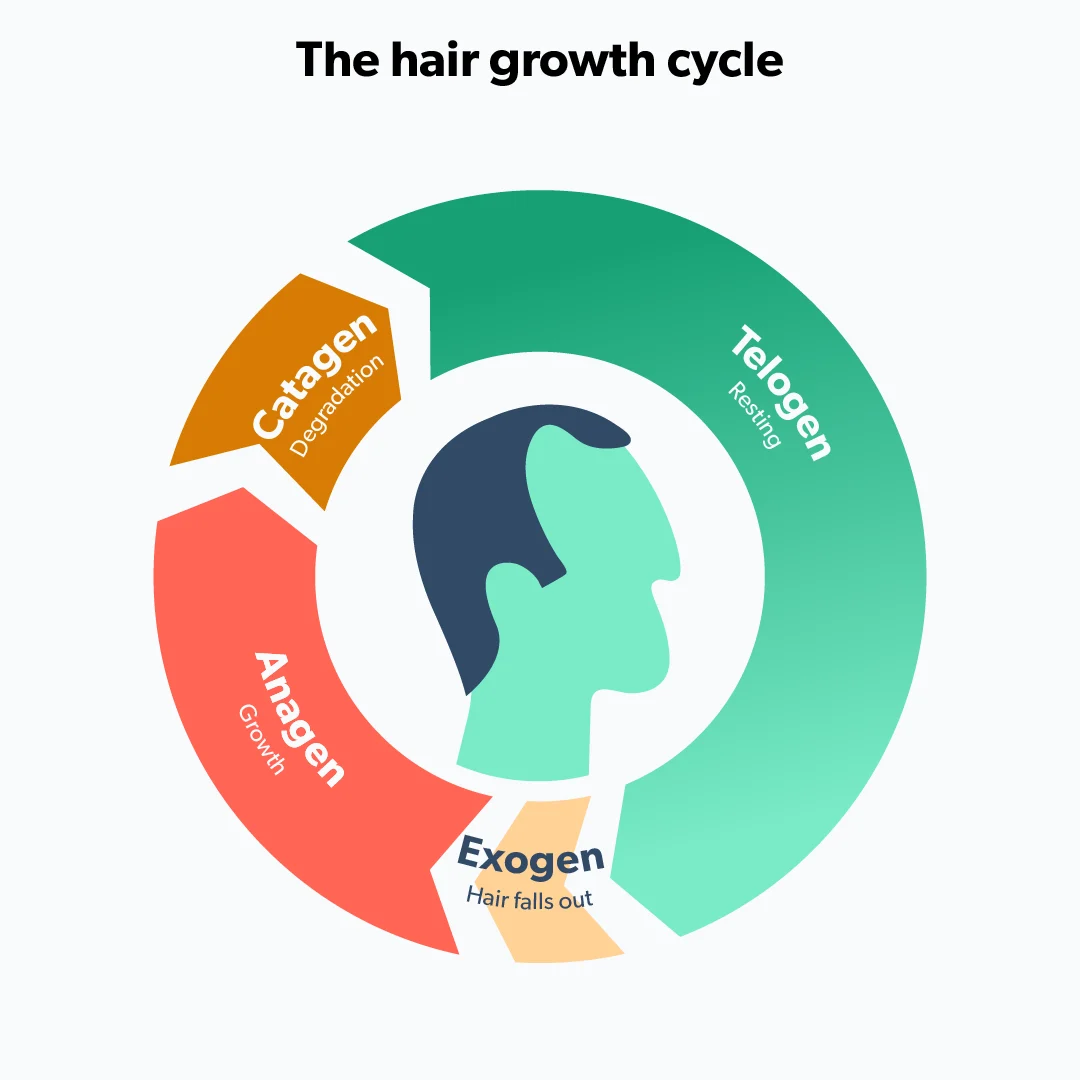Here's what we'll cover
Here's what we'll cover
About 95% of thinning hair is caused by male pattern hair loss, also known as androgenetic alopecia. This type of hair loss is caused by a hormone called dihydrotestosterone (DHT for short).
But DHT giveth and DHT taketh away. Although DHT is crucial for forming pubic and body hair, it can also cause you to lose hair on your scalp. Researchers aren't entirely sure why. By age 50, more than half of men in the US will experience hair loss caused by DHT. Medications that block DHT, such as finasteride, can help.
Finasteride Important Safety Information: Read more about serious warnings and safety info.
What is DHT?
DHT is a potent form of testosterone, a male sex hormone you’ve likely heard of before. It’s known as an androgen, a hormone that contributes to typical male characteristics like a deeper voice, increased muscle mass, and body hair. DHT, in particular, aids in the development of male genitalia during fetal development, and growth during puberty.
In men, testosterone is converted into DHT. After it's created, DHT flows freely through your bloodstream to other parts of the body. So how exactly does it relate to hair loss? DHT can bind to receptors on hair follicles in your scalp––especially if you're genetically predisposed to hair loss. This causes follicles to shrink, gradually producing less robust hair more prone to breakage, and eventually halts hair growth altogether.
And it seems that men who are losing their hair may have more of this type of testosterone than guys with luscious locks. Research has shown that they have more receptors for DHT, making them more susceptible to its effects, as well as higher levels of the enzyme that produces it, resulting in more of the final product (Vierhapper, 2001). Besides hair loss, high DHT levels can contribute to prostate issues including an enlarged prostate.
How DHT contributes to balding
It’s estimated each of us has roughly 100,000 hairs on our scalps and we lose (and sprout) about 100 hairs a day. That's part of the natural hair cycle. Hair follicles on our scalp are continuously growing and shedding hair in a cycle that has three distinct phases:
Growth phase: Also called the anagen phase, hairs stay here for 2 to 6 years. Most hairs on your scalp (about 80–90%) are in this phase right now.
Catagen phase: In this very short phase (14–21 days), hairs stop growing and detach from their blood supply in preparation for the resting phase.
Resting phase: The last phase of the cycle is the resting (telogen) phase. Here follicles lie dormant for about three months until the hair falls out. Between 10–20% of all the hair on your head is in the resting phase at any given time.

Once the resting phase is over, the growth phase begins again. You typically see hair lengthen by about a half an inch within a month, or six inches a year.
However, higher levels of DHT shrink hair follicles, shortening the growth phase and creating thinner hair. It can be alarming to notice hair thinning or falling out, but there are treatments that can successfully regrow your hair. Certain medications (which we’ll look at below) can actually reverse hair loss by increasing follicle size and promoting the growth of new hair.
However, there is a window of time for reversal to work. The more time goes by without treatment, changes will continue making hair regrowth less likely (Sinclair, 2015).
DHT and genetics
Genes determine whether your hair will stay or go, and when. Some people have a full head of hair well into their 60s and beyond, while others start losing it in their 20s.
You may have heard that male pattern hair loss comes from your mother's father. While this may be true in some people, genetics are a little more complicated. Research has found over 250 genes that influence hair loss, which can be inherited from either parent (Hagenaars, 2017).
Science suggests that some people are more susceptible to DHT's damaging effects on hair because of variations in their genes. Those variations can increase the sensitivity of androgen receptors in your scalp, making you more likely to experience hair loss.
How to reduce DHT levels
If you're experiencing hair loss, there are things you can do to stem the loss and increase hair growth.
Treatments that block or inhibit the production of DHT may slow or reverse balding. A DHT blocker is an oral or topical medication that works by preventing testosterone from being converted into DHT. Let’s take a look at a couple of popular options.
Finasteride
Finasteride (brand name Propecia) is a drug known as a 5-alpha-reductase inhibitor (we know, it’s a mouthful). Since 5-alpha-reductase is responsible for converting testosterone to DHT, inhibiting that also blocks the production of DHT.
When used for hair loss, finasteride is taken at a dosage of 1 mg a day. In clinical trials, researchers noted that finasteride stopped hair loss progression in 86% of men who took it, and 65% of them experienced increased hair regrowth (AHLA, n.d.).
According to one meta-analysis, finasteride was found to be superior to placebo in regrowing hair. With positive results seen in many study participants, the drug was deemed effective for promoting hair growth in men with hair loss (Adil, 2017).
DHT-blocking shampoo
Several varieties of shampoo claim to block DHT's effects on hair follicles. They're considered less effective than finasteride. Some of these shampoos contain zinc, vitamin B12, or an antifungal medication called ketoconazole (the active ingredient in the dandruff shampoo Nizoral). It’s hypothesized that ketoconazole, in combination with finasteride, can disrupt DHT's effects on the scalp (Hugo Perez, 2004).
Side effects of DHT blockers
The good news is that the majority of men who use DHT blockers like finasteride don't experience side effects. While uncommon, side effects that have been reported include:
Reduced sex drive
Trouble getting or keeping an erection
Lower volume of semen
In most cases, side effects go away after discontinuing the medication. Adverse reactions are more likely with higher doses of finasteride that are taken for a prostate condition called benign prostatic hyperplasia, not among people taking lower doses for hair loss. Women who are pregnant or may become pregnant and children should not use finasteride.
Other ways to treat hair loss
Minoxidil
Minoxidil (brand name Rogaine) is an over-the-counter liquid or foam that is applied to the scalp twice a day. It works as a peripheral vasodilator, which means it opens up blood vessels to increase blood flow and encourage new hair growth.
Minoxidil doesn't have a direct effect on DHT, but studies show that using this topical treatment and finasteride together is more effective than using either one alone. And know that minoxidil will be effective whether it's the pricey brand preparation, Rogaine, or the inexpensive generic version sold online for a few dollars a bottle.
Red light therapy
Low-level laser light therapy (LLLT) is an FDA-cleared way to treat hair loss. These devices come in the form of a wand you point at the scalp or a cap you can wear. They emit a constant red LED light that’s thought to reduce inflammation and improve blood flow to hair follicles.
Studies have found that both minoxidil and LLLT were effective treatments in regrowing hair lost to male pattern baldness (Adil, 2017).
Platelet-rich plasma treatments
Some dermatologists and hair-replacement specialists offer platelet-rich plasma (PRP) treatments. This is where a patient's blood is drawn, and then the plasma is extracted and injected into the scalp.
The theory is that the growth factors in platelets can spur hair growth. One study found that PRP treatment increased the number of hairs and overall hair density compared to areas treated with a placebo (Gentile, 2017).
Hair transplant
A hair transplant is a surgical procedure that moves hair from one place to another. The hairs on the back and sides of the head are more resistant to DHT (even into old age) than hairs on the top of the head. This is why hair is moved from the sides of the scalp into areas of balding to provide a longer-lasting solution.
If you’re experiencing hair loss, speak to a healthcare provider about treatment options. The faster you start treatment, the more hair you can keep.
Oral Minoxidil Important Safety Information: Read more about serious warnings and safety info.
DISCLAIMER
If you have any medical questions or concerns, please talk to your healthcare provider. The articles on Health Guide are underpinned by peer-reviewed research and information drawn from medical societies and governmental agencies. However, they are not a substitute for professional medical advice, diagnosis, or treatment.
Adil, A., & Godwin, M. (2017). The effectiveness of treatments for androgenetic alopecia: A systematic review and meta-analysis. Journal of the American Academy of Dermatology, 77 (1), 136–141. doi:10.1016/j.jaad.2017.02.054. Retrieved from https://www.ncbi.nlm.nih.gov/pubmed/28396101
American Hair Loss Association (AHLA). (n.d.). Men’s Hair Loss: Treatment . Retrieved from https://www.americanhairloss.org/men_hair_loss/treatment.html
Chandrashekar, B. S., Nandhini, T., Vasanth, V., Sriram, R., & Navale, S. (2015). Topical minoxidil fortified with finasteride: An account of maintenance of hair density after replacing oral finasteride. Indian Dermatology Online Journal, 6 (1), 17–20. doi:10.4103/2229-5178.148925. Retrieved from https://www.ncbi.nlm.nih.gov/pubmed/25657911
Gentile, P., Cole, J., Cole, M., Garcovich, S., Bielli, A., Scioli, M., … Cervelli, V. (2017). Evaluation of Not-Activated and Activated PRP in Hair Loss Treatment: Role of Growth Factor and Cytokine Concentrations Obtained by Different Collection Systems. International Journal of Molecular Sciences, 18 (2), E408. doi:10.3390/ijms18020408. Retrieved from https://www.ncbi.nlm.nih.gov/pubmed/28216604
Hagenaars, S. P., Hill, W. D., Harris, S. E., Ritchie, S. J., Davies, G., Liewald, D. C., … Marioni, R. E. (2017). Genetic Prediction of Male Pattern Baldness. PLoS Genetics, 13 (2). doi:10.1371/journal.pgen.1006594. Retrieved from https://journals.plos.org/plosgenetics/article?id=10.1371/journal.pgen.1006594
Hugo Perez, B. S. (2004). Ketoconazole as an adjunct to finasteride in the treatment of androgenetic alopecia in men. Medical Hypotheses, 62 (1), 112–115. doi:10.1016/s0306-9877(03)00264-0. Retrieved from https://www.sciencedirect.com/science/article/abs/pii/S0306987703002640
Sinclair, R., Torkamani, N., & Jones, L. (2015). Androgenetic alopecia: new insights into the pathogenesis and mechanism of hair loss. F1000 Research , 4,
doi:10.12688/f1000research.6401.1. Retrieved from https://www.ncbi.nlm.nih.gov/pubmed/26339482
Vierhapper, H., Nowotny, P., Maier, H., & Waldhäusl, W. (2001). Production rates of dihydrotestosterone in healthy men and women and in men with male pattern baldness: determination by stable isotope/dilution and mass spectrometry. The Journal of Clinical Endocrinology and Metabolism, 86 (12), 5762–5764. Doi: 10.1210/jcem.86.12.8078. Retrieved from https://pubmed.ncbi.nlm.nih.gov/11739436/










